Review
Our Gospel journey through holidays started during the Fall-Halloween season, when we reflected on the Curse God placed on the world. God promised a Conqueror at that time, who would one day defeat our adversary, the devil (Gen. 3:14-15). If you haven’t read part 1 of this series, I suggest doing so before continuing.
Our journey resumed in the dead of Winter, at Christmas, when we celebrated the arrival of this Conqueror into a spiritually dark world. The birth of Jesus was a partial fulfillment of the Seed prophecy of Gen. 3:15. If you haven’t yet read part 2 of this series, I suggest doing so before continuing.
The Cross of Christ
Now, we come to the third and most important part of this year-long Gospel presentation—the Cross of Christ.
- The Fall and the Promise of Christ – Halloween
- The Arrival of Christ – Christmas
- The Cross of Christ – Easter
- The Return of Christ
While it’s important to understand the origins of sin and the arrival of its conqueror, it’s all for nothing without the Cross. No one can be saved without knowing who Jesus is and what he accomplished at Calvary.
Easter
The Most Important Holiday
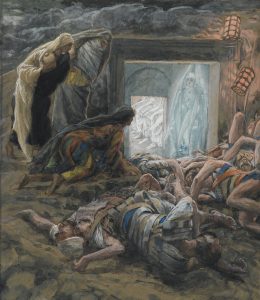
James Tissot (French, 1836-1902). Mary Magdalene and the Holy Women at the Tomb, 1886-1894. Brooklyn Museum, Purchased by public subscription, 00.159.329
The Crucifixion and Resurrection, by far, are the most important elements of the Gospel message. Paul said,
1Cor. 15:3 For what I received I passed on to you as of first importance: that Christ died for our sins according to the Scriptures, 4 that he was buried, that he was raised on the third day according to the Scriptures,
Admittedly, Easter may not be the most festive or fun holiday, as far as symbols and activities go. Christmas would be hard to top in that category. Theologically speaking, however, Easter is first. As wonderful as the celebration of Christmas is, without Easter, it is meaningless.
The History of Easter
The tradition of setting aside an annual celebration of the Crucifixion and Resurrection is very old, going all the way back to the first or second century. Easter started, in essence, as a Christianized Passover celebration. Since Jesus was crucified during the time of the passover, it made sense for early Christians to focus on him during Jewish Passover celebrations. He, after all, is our Passover Lamb. (For more on this, see, What is the Passover Lamb? How is Jesus our Passover Lamb?)
Critics of Easter are quick to point out that the New Testament never calls for such an annual celebration, and they are correct (on that small point). They fail, however, to see the larger point of Christian liberty in the New Testament Church age. Paul made it clear in Romans 14 that we are free to set aside sacred days, in accordance with our conscience (Rom. 14:5). Considering the centrality of the Cross, it’s only fitting these annual celebrations arose very early in Church history.
The earliest writings about Easter go back to the second century, and most agree they likely started in the first century (source). For an overview of the origins of Easter, I recommend this helpful article: What is the History of the Easter Holiday?
Using Easter Symbols
I believe, we, as Christians, need to take advantage of every Gospel opportunity that comes our way, and Easter season might be the biggest. It is filled with wonderful usable symbols that point to the events and the effects of the Cross.
Many stumble on these symbols, however—particularly a couple of them. I know I did. For many years, I was convinced eggs and bunnies were pagan infiltrators meant to subvert the true message of the holiday. I was wrong, and will do my best to explain why I was wrong.
Please note, however, regardless of how convincing my case may be, Christians are only obligated to God and their conscience (Rom. 14:12-23). We are free to use or ignore any symbol out there. God owns them all and no one has a monopoly on how they’re used. “Let each be convinced in his own mind.” (Rom. 14:5)
The Cross
That said, let’s start with a non-controversial symbol. Easter is all about the Cross of Christ. The Cross is, without question, the chief symbol of Easter and the entire Christian faith. It is the instrument by which Christ, our Passover Lamb, became our sacrifice. It’s also interesting that, even before his disciples knew of his fate on the Cross, Jesus instructed them to take up this symbol.
Matt. 16:24 Then Jesus said to His disciples, “If anyone desires to come after Me, let him deny himself, and take up his cross, and follow Me.
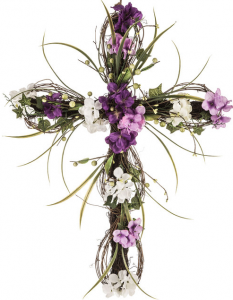 The message of the Cross is simple. We were once separated from God, without hope. Adam, our forefather, fell (became separated from God) in the Garden, and we with him. God gave us the Law through Moses, but no one could keep it.
The message of the Cross is simple. We were once separated from God, without hope. Adam, our forefather, fell (became separated from God) in the Garden, and we with him. God gave us the Law through Moses, but no one could keep it.
Then, Jesus arrived! Dying on the Cross, he took away the requirements of the Law. He then rose again, triumphing over our spiritual enemies. Those who repent and trust in him are forgiven and given new life in him. Paul said it better.
Col. 2:13 And you, being dead in your trespasses and the uncircumcision of your flesh, He has made alive together with Him, having forgiven you all trespasses, 14 having wiped out the handwriting of requirements that was against us, which was contrary to us. And He has taken it out of the way, having nailed it to the cross. 15 Having disarmed principalities and powers, He made a public spectacle of them, triumphing over them in it.
Display crosses everywhere on Easter. Talk to your kids about what they represent.
The Empty Tomb
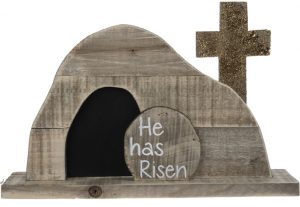 The Crucifixion is incomplete without the Resurrection. Christ conquered death by raising himself from the dead.
The Crucifixion is incomplete without the Resurrection. Christ conquered death by raising himself from the dead.
John 2:19 Jesus answered and said to them, “Destroy this temple, and in three days I will raise it up.”
Remind your kids that, just as Jesus was raised, so we will be also— those of us who are found in him.
2Cor. 4:14 knowing that He who raised up the Lord Jesus will also raise us up with Jesus, and will present us with you.
Spring Season
Unlike the two symbols above which point to the events of Easter, the remaining symbols we’ll discuss point to the effects of Easter—namely, new life! Most traditional Easter symbols are related to Spring, which, in and of itself, is a wonderful symbol of new life.
 The vernal (Spring) equinox, around March 21, is that time of year when the lengths of the day and the night become equal—12 hours each. Going forward, the days become longer and the nights shorter. It’s the exact opposite of what happened at the Fall equinox. For more on this, review the first article of this series.
The vernal (Spring) equinox, around March 21, is that time of year when the lengths of the day and the night become equal—12 hours each. Going forward, the days become longer and the nights shorter. It’s the exact opposite of what happened at the Fall equinox. For more on this, review the first article of this series.
Spring is the season of increasing daylight. It’s about blooming flowers and flourishing wildlife. It’s characterized by new births and hatchings all over the planet. Spring, therefore, becomes the perfect analogy for the new spiritual birth we receive when we come to the Cross.
Resurrection Season
It’s also notable that God may have had a hand in this symbolism. We don’t know the season Jesus was born (though we celebrate it during winter), but we do know when he was resurrected. Jesus definitely rose in the Spring. The arrest, crucifixion and resurrection of Jesus all took place during the time of the Passover, beginning on Nissan 14 on the Jewish calendar.
Was this an accident? Impossible. Coincidence? I doubt it. I won’t be dogmatic, but it makes sense that God, from eternity past, would choose to resurrect Jesus in the Spring. The symbolism is too perfect to be coincidental.
Regardless, I recommend using Spring season to explain new life to your kids. Use the Spring decor that’s so abundant during Easter, to illustrate the new life we have in Christ. As the angel commanded the apostles after freeing them from their chains, “Go, stand in the temple courts and tell the people all about this new life.” (Acts 5:20)
Easter Colors and Flowers
 Just as evergreen colors symbolized life during Christmas season, so pastel colors symbolize life during Easter. In fact, they symbolize new life. Spring is that time of year when new flowers of numerous colors emerge from dead foliage. They can remind us of Christ’s resurrection from the dead, and of our new life in him, after being dead in our sins and trespasses.
Just as evergreen colors symbolized life during Christmas season, so pastel colors symbolize life during Easter. In fact, they symbolize new life. Spring is that time of year when new flowers of numerous colors emerge from dead foliage. They can remind us of Christ’s resurrection from the dead, and of our new life in him, after being dead in our sins and trespasses.
Rom. 6:4 We were therefore buried with him through baptism into death in order that, just as Christ was raised from the dead through the glory of the Father, we too may live a new life.
Pastel colors and flowers can also represent abundant life. Jesus said he came to give us life, and give it abundantly (John 10:10). Easter colors build on Christmas colors and surpass them. Use them to explain abundant life to your kids.
Easter Lilies
While any flower can be used to convey the message of new life, lilies, historically, have been the most prominent. Called by some, “white-robed apostle of hope”, their white pure flowers and trumpet shape has set them apart. For more on their history, see: The History of the Easter Lily & How It Became the Most Popular Easter Flower.
Let your kids know that Christians will be adorned like lilies, one day.
Rev. 6:11 Then a white robe was given to each of them; and it was said to them that they should rest a little while longer, until both the number of their fellow servants and their brethren, who would be killed as they were, was completed.
Trumpet this truth often, especially during Easter season.
Easter Eggs
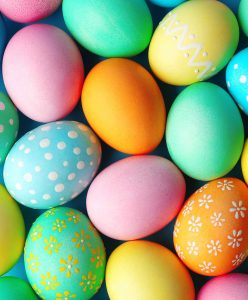 Egg production, especially in pre-technology times, slowed drastically in the Winter, and naturally bounced back in the Spring. Eggs, therefore, became natural Spring symbols. They are obvious symbols of life, in that they produce life and also provide food. It should be no surprise Christians found them useful.
Egg production, especially in pre-technology times, slowed drastically in the Winter, and naturally bounced back in the Spring. Eggs, therefore, became natural Spring symbols. They are obvious symbols of life, in that they produce life and also provide food. It should be no surprise Christians found them useful.
Pagan Origins of Easter Eggs?
They are a bit controversial, however. Perhaps, like me, you’ve heard Easter eggs are fertility symbols honoring a Saxon goddess named Eastre (or Eostre). It’s not true. In fact, it’s doubtful this goddess was ever worshipped by anyone. She is only mentioned in passing by one eighth century historian and not found anywhere else in historical writings or artifacts. The predominance of evidence suggests she never existed in the minds of ancient pagans or anyone else. We’ll discuss this further in the concerns and objections section.
That said, it should not matter to Christians, either way. We need not worry what symbols ancient pagans used. God created the egg and no one has a monopoly on its symbolism. I would surmise, however, that some may be comforted by the fact that these pagan rumors are false. For further reading, see: Are “Easter eggs” biblical?.
The True History of Easter Eggs
 While the precise details of the origins of Easter eggs are unclear, there are viable explanations to consider. The article linked above (Are “Easter eggs” biblical?) points out that eggs were and are prominent symbols of the Passover Seder. Since Easter was born out of the Passover celebration, it’s easy to see how this symbolic element transferred over. In Jewish tradition, Seder eggs symbolize new life. As one writer explains,
While the precise details of the origins of Easter eggs are unclear, there are viable explanations to consider. The article linked above (Are “Easter eggs” biblical?) points out that eggs were and are prominent symbols of the Passover Seder. Since Easter was born out of the Passover celebration, it’s easy to see how this symbolic element transferred over. In Jewish tradition, Seder eggs symbolize new life. As one writer explains,
One of the reasons we have the egg at the Seder is because it symbolizes the beginning of life, and Passover marks the very beginning of our national existence.
He goes on to explain, that eggs more precisely represent potential life, being that the Jewish people were freed from Egypt, but not quite yet where they wanted to be.
Let’s look at the journey of our egg. The egg is first inside the hen. It is then laid and thereby freed from the constraints previously imposed upon it. But has the egg been hatched? Has a little chick emerged from the shell yet? The answer is no. The egg, you see, is only potential life. It is not yet a living being. One day, please G‑d, a chick will emerge and the cycle of life will continue. (source)
New Abundant Life
For Christians, however, this “potential life” has been realized in Christ. Through Christ, anyone can have life and have it abundantly.
John 10:10 ….I have come that they may have life, and that they may have it more abundantly.
Thus, Christians began to die eggs red to symbolize Christ’s sacrifice, and die them Spring colors to symbolize the new life it brings.
It’s also notable that Easter celebrations, historically, have been preceded by fasts of various lengths (in some cases, 40 days!). Since chickens don’t halt production during these Spring fasting periods, egg stockpiles would have multiplied. It should be no surprise Christians found creative symbolic uses for them. Don’t let this symbolism dye (pun intended). Easter eggs represent new life. Let your kids know how to get this new life.
Easter Bunnies
In addition to flowers and eggs, certain animals also convey Spring, and by extension, new life. The most prominent, no surprise, are rabbits and hares.
Though charges of paganism abound, I don’t believe this symbol was borrowed from pagans, either. I wouldn’t mind hijacking it if it was, but there is no evidence to support this claim. To my knowledge, there was no goddess named Eostre worshipped by the Saxons or any other pagans, and there is no fertility goddess in the vicinity associated with hares or rabbits. For more on this, see: Is the Easter Bunny a pagan symbol?
Protestant Christian Origins
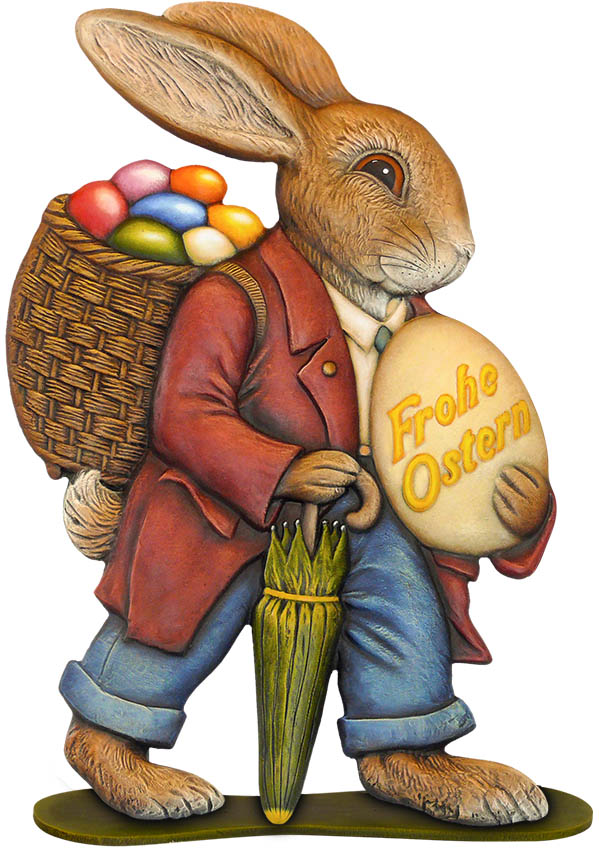 In all likelihood, German Protestant Christians invented the Easter Bunny (Osterhase). Rabbits and hares likely became associated with Easter because of their Springtime prominence. They are noticeably visible and active in Spring, in fact, some say they go crazy in the Spring (See: Do Rabbits Really Go Crazy in March?). Christians likely adopted them, not as fertility symbols per se, but as new life symbols, seeing how rabbits and hares emerge so abundantly at the close of Winter. It’s not hard to see how this symbolism arose, especially considering how German Protestants emphasized born-again theology.
In all likelihood, German Protestant Christians invented the Easter Bunny (Osterhase). Rabbits and hares likely became associated with Easter because of their Springtime prominence. They are noticeably visible and active in Spring, in fact, some say they go crazy in the Spring (See: Do Rabbits Really Go Crazy in March?). Christians likely adopted them, not as fertility symbols per se, but as new life symbols, seeing how rabbits and hares emerge so abundantly at the close of Winter. It’s not hard to see how this symbolism arose, especially considering how German Protestants emphasized born-again theology.
John 3:3 ….“Very truly I tell you, no one can see the kingdom of God unless they are born again….6 Flesh gives birth to flesh, but the Spirit gives birth to spirit. 7 You should not be surprised at my saying, ‘You must be born again.’
While the precise details of their origins has been lost, the above is much more feasible than the pagan goddess theory. For further reading, see: What is the origin of the Easter bunny and Easter eggs? and also, Does Easter have a pagan derivation?
I, personally, see no reason why the Easter Bunny, even a magical egg-hiding bunny, cannot symbolize the new birth and new life we have in Christ.
1Pet. 1:23 For you have been born again, not of perishable seed, but of imperishable, through the living and enduring word of God.
Easter Chicks and Hatchlings
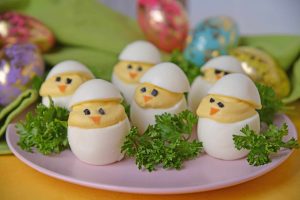 Chicks and hatchlings are also prominent symbols of Easter for the same reason flowers, eggs and bunnies are. They are prominent in the Spring. Hatchling numbers would naturally decline in the Winter, and bounce back in Spring. It’s easy to see how they became new life symbols. Put them to work. Let your kids know what they represent.
Chicks and hatchlings are also prominent symbols of Easter for the same reason flowers, eggs and bunnies are. They are prominent in the Spring. Hatchling numbers would naturally decline in the Winter, and bounce back in Spring. It’s easy to see how they became new life symbols. Put them to work. Let your kids know what they represent.
John 5:24 “Most assuredly, I say to you, he who hears My word and believes in Him who sent Me has everlasting life, and shall not come into judgment, but has passed from death into life.
Using Easter Traditions
Easter also has an abundance of traditional events and activities that can create valuable opportunities for the Gospel. Here are a few:
Good Friday Service
Good Friday, for us, is the most sober holiday of the year. If you want to fully appreciate the Resurrection, it’s important to understand the Crucifixion that preceded it. Our free gift of salvation came at a tremendous price which we can never forget. Make sure your kids know why this needed to happen. A review of the first article in this series may help.
Easter Sunrise Service
Yes, getting up at dark is hard, but it’s worth it on Easter morning. Jesus arose in the twilight of the morning, just prior to the sunrise. Biblical morning or dawn is that time when night begins to transition to day. We’re told Mary Magdalene either left for the tomb, or arrived at the tomb at this time before the full daylight.
John 20:1 Now the first day of the week Mary Magdalene went to the tomb early, while it was still dark, and saw that the stone had been taken away from the tomb.
Jesus merely needed to stay dead an instant after dawn on the first day of the week (Sunday) in order to fulfill his time in the heart of the earth. There was no need for him to stay any longer, which is why his body was missing even before dawn was complete.
I recommend going to sunrise service if your church offers one. It can be a great way to get into the minds of those who first discovered the empty tomb. Let the dawn of Easter morning symbolize the dawn of life you received when you first believed.
Easter Sunday Service
Without question, Easter is the highest Church attendance day of the year. For whatever reason, seekers like going to Church on Easter Sunday. For this reason, many pastors deliver their best Gospel presentation of the year. Take advantage of it! Invite friends and family. While there’s always a good chance they’ll say no, there’s a better chance they’ll say yes on Easter Sunday.
Don’t get me wrong, salvation is never about the odds. God is sovereign over salvation. That said, if Easter Sunday is opening doors for the Gospel, you can rest assured, God has a hand in it.
Passion Plays
I love Passion plays. In fact, I like them more than some popular Passion movies. For one, they’re less gory, and more kid-friendly. They’re also more endearing, with non-professional actors and producers.
This is not to say the Gibson movie doesn’t have its place. I believe it does, and has moved many over the years. But a hometown Passion play, to me, is a great opportunity for outreach, not only sharing the message of the Cross, but introducing people to the Christian community. If one of these exists near you, take advantage of it.
Dying Easter Eggs
 I find dying Easter eggs to be the perfect time to talk about what they represent. What better time could there be to explain their symbolism? Eggs contain new life, and they also provide food to sustain life. Adding Spring coloring to them only reinforces this symbolism.
I find dying Easter eggs to be the perfect time to talk about what they represent. What better time could there be to explain their symbolism? Eggs contain new life, and they also provide food to sustain life. Adding Spring coloring to them only reinforces this symbolism.
Rom. 6:4 We were therefore buried with him through baptism into death in order that, just as Christ was raised from the dead through the glory of the Father, we too may live a new life.
Hunting Easter Eggs
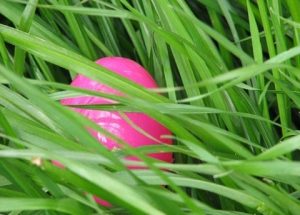 Every year, millions of kids hunt these wonderful symbols. Rarely, however, do I see good symbolism attached to this activity. Let’s change this. Scripture is filled with exhortations about seeking God and seeking the lost.
Every year, millions of kids hunt these wonderful symbols. Rarely, however, do I see good symbolism attached to this activity. Let’s change this. Scripture is filled with exhortations about seeking God and seeking the lost.
Heb. 11:6 But without faith it is impossible to please Him, for he who comes to God must believe that He is, and that He is a rewarder of those who diligently seek Him.
Jesus, himself, exhorted men to seek.
Luke 11:9 “So I say to you, ask, and it will be given to you; seek, and you will find; knock, and it will be opened to you. 10 For everyone who asks receives, and he who seeks finds, and to him who knocks it will be opened.
Next Easter, after hunting is complete, discuss these concepts with your kids. While enjoying the fruits of their labor, tell them about the real prize that all men need to seek—new life. Let them know this Life is a person.
John 14:6 Jesus said to him, “I am the way, the truth, and the life. No one comes to the Father except through Me.
Making Easter Baskets
I, personally, use Easter baskets to explain the importance of Christian fellowship and togetherness. If Easter eggs symbolize new life, the gathering of these new lives into baskets could remind us of the importance of the church assembly.
Heb. 10:24 And let us consider one another in order to stir up love and good works, 25 not forsaking the assembling of ourselves together, as is the manner of some, but exhorting one another, and so much the more as you see the Day approaching.
Christian fellowship is not an option. It’s essential and commanded in Scripture. Logs that burn together burn brightly. Logs that burn alone die quickly. Use Easter baskets to explain this truth to your kids.
Easter Brunch/Dinner
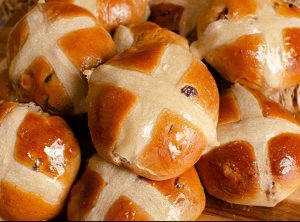 Feasting, in and of itself, carries significant theological symbolism. We will one day dine with Christ—those of us who have come to the Cross for forgiveness. You can read about it here: What is the marriage supper of the Lamb?
Feasting, in and of itself, carries significant theological symbolism. We will one day dine with Christ—those of us who have come to the Cross for forgiveness. You can read about it here: What is the marriage supper of the Lamb?
Enjoy, therefore, your Easter feast with all its traditional fixings. Go all out, as you look forward to the better feast that is coming.
Concerns, Objections and Confusion
The Date of Easter Every Year
Why are Easter dates so drastically different year to year?
While this isn’t a concern, per se, it is a source of confusion. Unlike Halloween and Christmas, Easter does not have a fixed solar calendar date. It’s based, rather, in part, on the lunar cycle, based loosely on the Jewish calendar. Easter occurs on the first Sunday, after the first full moon, after the vernal equinox. Clear as mud??
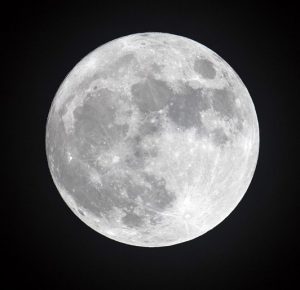 Simply put, the date of Easter, every year, is based on the first full moon of Spring. It is always the first Sunday after the first full moon after March 21 (the first day of Spring according to the traditional Church calendar). This creates a lot of possibilities, as the first Spring full moon can occur up to 29 days after this date. In addition, Sunday can occur up to 7 days after that. The dates of Easter, therefore, can span from March 22 to April 25.
Simply put, the date of Easter, every year, is based on the first full moon of Spring. It is always the first Sunday after the first full moon after March 21 (the first day of Spring according to the traditional Church calendar). This creates a lot of possibilities, as the first Spring full moon can occur up to 29 days after this date. In addition, Sunday can occur up to 7 days after that. The dates of Easter, therefore, can span from March 22 to April 25.
Some fun facts: The last time Easter occurred on the earliest possible date, March 22, was in 1818. This won’t happen again until 2285. The last time it was on the latest possible date, April 25, was in 1943. This won’t happen again until 2038. source. Mark your calendars!
A Pagan Goddess?
The name Easter comes from a pagan goddess that Christians borrowed to appease their culture.
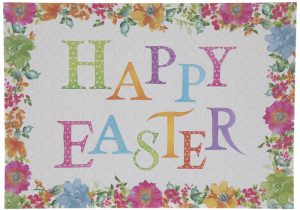 This is simply not the case. In fact, you may find it interesting that, in most languages, the word for Easter is not derived from the word East, but rather from the Hebrew word for Passover—Pesach. Take a look at the following words for Easter in other languages.
This is simply not the case. In fact, you may find it interesting that, in most languages, the word for Easter is not derived from the word East, but rather from the Hebrew word for Passover—Pesach. Take a look at the following words for Easter in other languages.
- Latin – Pascha or Festa Paschalia
- Greek – Paskha
- Bulgarian – Paskha
- Danish – Paaske
- Dutch – Pasen
- Finnish – Pääsiäinen
- French – Pâques
- Indonesian – Paskah
- Irish – Cáisc
- Italian – Pasqua
- Lower Rhine German – Paisken
- Norwegian – Påske
- Portuguese – Páscoa
- Romanian – Pasti
- Russian – Paskha
- Scottish Gaelic – Càisg
- Spanish – Pascua
- Swedish – Påsk
- Welsh – Pasg (source)
Would this have happened if Easter was a revived pagan festival?
Eastre (Eostre)
One might then ask, Why are the English and German words different? Did they succumb to pagan influence?
Not at all. We’ve all heard the rumor that Easter was named after a Saxon goddess named Eastre (or Eostre). I can assure you, that’s all this is—a rumor. Easter comes from the word East (Osten in German) possibly because the sun was rising in the East when Christ rose from the dead. Ostern also has etymological ties to the word dawn, which would also tie into the Resurrection account.
Furthermore, it’s doubtful that a goddess named Eastre or Eostre ever existed in the minds of ancient pagans. So far, no historical nor archaeological evidence has turned up to verify her worship. The rumor has its roots in the writings of the Venerable Bede, an eighth century English monk and historian. He made a passing reference to this deity in his treatise on Saxon culture in 725 Ad. Per GotQuestions.org,
The only mention of Eastre comes from a passing reference in the writings of the Venerable Bede, an eighth-century monk and historian. Bede wrote, “Eosturmonath has a name which is now translated as ‘Paschal month,’ and which was once called after a goddess of theirs named Eostre, in whose honor feasts were celebrated in that month. Now they designate the Paschal season by her name, calling the joys of the new rite by the time-honoured name of the old observance” (De Temporum Ratione). (source)
History and archaeology, however, have not corroborated this claim. The Got Questions article continues,
And that’s it. Eostre is not mentioned in any other ancient writing; we have found no shrines, no altars, nothing to document the worship of Eastre. It is possible that Bede simply extrapolated the name of the goddess from the name of the month.
The True Origins of the Name Easter
The most logical explanation is that Easter and Ostern were derived from the word East or even more likely from the word dawn. From GotQuestions.org:
Others contend that the word Easter ultimately derives from the Latin phrase in albis, related to alba (“dawn” or “daybreak” in Spanish and Italian). In Old High German, albis became eostarum, which eventually became Ostern in modern German and Easter in English.
If so, the connection to the Resurrection would seem obvious. Jesus rose at dawn, when the sun was rising in the East. While dogmatism is impossible, this is much more logical than the pagan goddess theory. Even Encyclopedia Britannica admits to the dubiousness of Christians naming their most important holiday after a pagan goddess.
Given the determination with which Christians combated all forms of paganism (the belief in multiple deities), this appears a rather dubious presumption. There is now widespread consensus that the word derives from the Christian designation of Easter week as in albis, a Latin phrase that was understood as the plural of alba (“dawn”) and became eostarum in Old High German, the precursor of the modern German and English term.
For more on this and other dubious claims about the pagan roots of Easter, I recommend this short free Kindle book by JP Holding: Easter is Pagan And Other Fables.
Easter Related to Ishtar?
Others claim Easter and its symbols are linked to Ishtar—a fertility goddess worshipped in some ancient Semitic cultures. The problem with this is, there is no etymological connection between her name and Easter. Even more problematic is the fact we don’t see her associated with eggs or bunnies in any way. Her symbolic animal, rather, was a lion.
For a complete refutation of the Ishtar theory, see: Easter and Good Friday: questions and answers – Does Easter have a pagan derivation? by Jonathan Sarfati
Final Thought
Easter is the oldest and most important Christian holiday. Its Spring-themed symbols are not pagan. They are Christian in origin and offer great opportunities to explain the new life we have in Christ, through the Cross. Use them as you see fit, in accordance with your conscience.
Next, we’ll take a closer look at a beloved national holiday, that may lend itself to some deeper theological symbolism.
Previous Articles:
Explaining the Gospel through Holidays – Part 1: Halloween
The Fall and the Promise of Christ
Explaining the Gospel through Holidays – Part 2: Christmas
The Arrival of Christ
Next Article:
Explaining the Gospel through Holidays – Part 4: Independence Day
The Return of Christ

Leave a Comment
You must be logged in to post a comment.